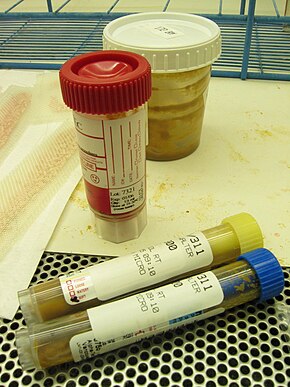Stool test
A stool test is a medical diagnostic technique that involves the collection and analysis of fecal matter. Microbial analysis (culturing), microscopy and chemical tests are among the tests performed on stool samples.
Collection
[edit]Stool samples should be sent to the laboratory as soon as possible after collection and should not be refrigerated prior to by the laboratory.[1]
Visual examination
[edit]The patient and/or health care worker in the office or at the bedside is able to make some important observations.
- Color
- Texture/consistency—formed
- Classify type of feces (diagnostic triad for irritable bowel syndrome) based on Bristol stool scale
Cancer screening
[edit]Fecal occult blood test and fecal immunochemical test are the most common stool tests to diagnose many conditions that caused by bleeding in the gastrointestinal system, including colorectal cancer or stomach cancer.[2] The American College of Gastroenterology has recommended the abandoning of gFOBT testing as a colorectal cancer screening tool, in favor of the fecal immunochemical test (FIT).[3] The newer and recommended tests look for globin, DNA, or other blood factors including transferrin, while conventional stool guaiac tests look for heme.
Cancers, and to a lesser extent, precancerous lesions, shed abnormal cells into the stool.[4] Cancers and precancerous lesions (polyps) that are ulcerated or rubbed by passing stool also may shed blood into the stool, which can be identified by a hemoglobin assay.[4]
The American Cancer Society and the U.S. Preventive Services Task Force recommended colorectal cancer screening with a fecal immunochemical test every year, or a multi-target stool DNA test for every three years from the age of 45.[5] Other options include a sigmoidoscopy or virtual colonoscopy (CT colonography) for every five years or a colonoscopy for every 10 years. Fecal occult blood test is no longer recommended due to the high false-positive rate as well as the dietary and pharmaceutical restrictions.[5][6] The National Committee for Quality Assurance (NCQA) issued an update to the Healthcare Effectiveness Data and Information Set (HEDIS) for 2017, while the guideline remains for the patients aged 50 or over.[7]
A multi-target stool DNA test was approved in August 2014 by the FDA as a screening test for non-symptomatic, average-risk adults 50 years or older.[8] A 2017 study found this testing to be less cost effective compared to colonoscopy or fecal occult blood testing.[9] Three-year multi-target stool DNA test has been estimated to cost $11,313 per quality-adjusted life year (QALY) compared with no screening.[10]
Microbiology tests
[edit]Parasitic diseases such as ascariasis, hookworm, strongyloidiasis and whipworm can be diagnosed by examining stools under a microscope for the presence of worm larvae or eggs. Some bacterial diseases can be detected with a stool culture. Toxins from bacteria such as Clostridioides difficile ("C. diff.") can also be identified. Viruses such as rotavirus can also be found in stools.[11] Other stool tests involve the detection of antibiotic resistance as to guide appropriate therapy, e.g. Clarithromycin resistance of Helicobacter pylori represents a major challenge in eradication therapy but the responsible bacterial genomic markers can be detected in stool using PCR technology and thus can guide the prescription of the appropriate antibiotics to specific patients.[12]
Chemical tests
[edit]A fecal pH test may be used to determine lactose intolerance or the presence of an infection.[13] Steatorrhea can be diagnosed using a fecal fat test, which checks for the malabsorption of fat.[14]
Faecal elastase levels are becoming the mainstay of pancreatitis diagnosis.
See also
[edit]References
[edit]- ^ "Approach to stool microscopy". medilib (in Persian). 2021-06-02. Retrieved 2022-08-16.
- ^ "Fecal Occult Blood Test (FOBT)".
- ^ Rex DK, Johnson DA, Anderson JC, Schoenfeld PS, Burke CA, Inadomi JM (March 2009). "American College of Gastroenterology guidelines for colorectal cancer screening 2009 [corrected]". The American Journal of Gastroenterology. 104 (3): 739–750. doi:10.1038/ajg.2009.104. PMID 19240699. S2CID 295873.
- ^ a b Osborn NK, Ahlquist DA (2005). "Stool screening for colorectal cancer: molecular approaches". Gastroenterology. 128 (1): 192–206. doi:10.1053/j.gastro.2004.10.041. PMID 15633136.
- ^ a b Tepus M, Yau TO (20 May 2020). "Non-Invasive Colorectal Cancer Screening: An Overview". Gastrointestinal Tumors. 7 (3): 62–73. doi:10.1159/000507701. PMC 7445682. PMID 32903904.
- ^ "American Cancer Society recommendations for colorectal cancer early detection". www.cancer.org. Archived from the original on 3 December 2016. Retrieved 14 July 2016.
- ^ National Committee for Quality Assurance. "Healthcare Effectiveness Data and Information Set 2017 Volume 2: Technical Update" (PDF).
- ^ "FDA approves first non-invasive DNA screening test for colorectal cancer [press release]". Food and Drug Administration. August 11, 2014. Retrieved 30 June 2015.
- ^ Barzi A, Lenz HJ, Quinn DI, Sadeghi S (1 May 2017). "Comparative effectiveness of screening strategies for colorectal cancer". Cancer. 123 (9): 1516–1527. doi:10.1002/cncr.30518. PMC 6879196. PMID 28117881.
- ^ Berger BM, Shroy PC, Dinh TA (2015). "Screening for Colorectal Cancer Using a Multitarget Stool DNA Test: Modeling the Effect of the Intertest Interval on Clinical Effectiveness". Clinical Colorectal Cancer. 15 (3): e65–e74. doi:10.1016/j.clcc.2015.12.003. PMID 26792032.
- ^ "Stool culture".
- ^ Mommersteeg MC, Nieuwenburg SA, Wolters LM, Roovers BH, van Vuuren HA, Verhaar AP, Bruno MJ, Kuipers EJ, Peppelenbosch MP, Spaander MC, Fuhler GM (November 2023). "The use of non-invasive stool tests for verification of Helicobacter pylori eradication and clarithromycin resistance". United European Gastroenterol J. 11 (9): e894-903. doi:10.1002/ueg2.12473. PMC 10637120. PMID 37854002.
- ^ "Stool Acidity Test - MedicineNet.com".
- ^ "MedlinePlus Medical Encyclopedia: Fecal fat".

